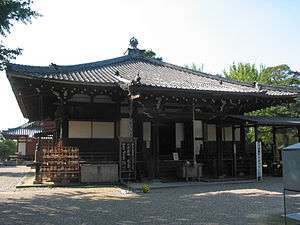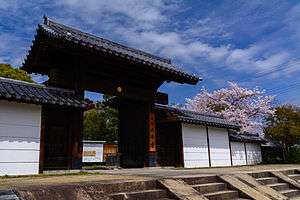Daian-ji
Coordinates: 34°40′05″N 135°48′46″E / 34.668°N 135.812722°E


Daian-ji (大安寺) was founded during the Asuka period and is one of the Seven Great Temples of Nara, Japan.
History
The Nihon Shoki records the founding of the Kudara Dai-ji (百済大寺), predecessor of the Daian-ji, in 639 during the reign of Emperor Jomei. A nine story pagoda was added shortly afterwards.[1] Moved during the reign of Emperor Temmu, excavations have uncovered the foundations of the site of the Daikandai-ji (大官大寺), as it was then known, seven hundred metres to the south of Mount Kagu.[2] Like the Yakushi-ji, and Gangō-ji, the temple relocated to the new capital of Heijō-kyō in 716/7, and it was rebuilt as the Daian-ji in 729.[3] Its importance declined when the capital moved again to Kyoto at the end of the Nara period. A succession of fires, a typhoon in 1459 and earthquakes in 1585 and 1596 destroyed most of the temple.[4] The stone bases of the former twin pagodas were removed for reuse at Kashihara Jingū in 1889,[5] while the ruins of the other buildings lie in adjacent properties.[3]
Treasures
The temple houses nine statues in a style known as Daianji-yoshiki, but the acclaimed statue of Sakyamuni, said by the twelfth-century Oe no Chikamichi in Shichidaiji Junrei Shiki to have been the finest work in Nara, is now lost.[3][6] The following Nara period statues have been designated Important Cultural Properties: a Jūichimen Kannon,[7] Senjū Kannon,[8] Fukūkensaku Kannon,[9] Yōryū Kannon,[10] Shō Kannon,[11] and a set of Four Heavenly Kings.[12] Temple records of the Tenpyō era (747) have also been designated an Important Cultural Property and are now held in Chiba Prefecture.[13]
See also
| Wikimedia Commons has media related to Daianji (Nara). |
- Nanto Shichi Daiji
- Thirteen Buddhist Sites of Yamato
- Historical Sites of Prince Shōtoku
- For an explanation of terms concerning Japanese Buddhism, Japanese Buddhist art, and Japanese Buddhist temple architecture, see the Glossary of Japanese Buddhism.
References
- ↑ McCallum, Donald F. (2009). The Four Great Temples (vid. pp. 90, 83-153). University of Hawaii Press. ISBN 978-0-8248-3114-1.
- ↑ "Temple". Daian-ji. Retrieved 28 March 2011.
- 1 2 3 Ooka, Minoru (1973). Temples of Nara and their Art (vid. pp. 33 f.). Weatherhill. ISBN 0-8348-1010-7.
- ↑ "History". Daian-ji. Retrieved 28 March 2011.
- ↑ Kidder, J. Edward (1972). Early Buddhist Japan (vid. p. 114). Thames and Hudson. ISBN 0-500-02078-7.
- ↑ "Daianji Temple". Nara Prefecture. Retrieved 28 March 2011.
- ↑ "Database of Registered National Cultural Properties". Agency for Cultural Affairs. Retrieved 27 March 2011.
- ↑ "Database of Registered National Cultural Properties". Agency for Cultural Affairs. Retrieved 27 March 2011.
- ↑ "Database of Registered National Cultural Properties". Agency for Cultural Affairs. Retrieved 27 March 2011.
- ↑ "Database of Registered National Cultural Properties". Agency for Cultural Affairs. Retrieved 27 March 2011.
- ↑ "Database of Registered National Cultural Properties". Agency for Cultural Affairs. Retrieved 27 March 2011.
- ↑ "Database of Registered National Cultural Properties". Agency for Cultural Affairs. Retrieved 27 March 2011.
- ↑ "Database of Registered National Cultural Properties". Agency for Cultural Affairs. Retrieved 27 March 2011.